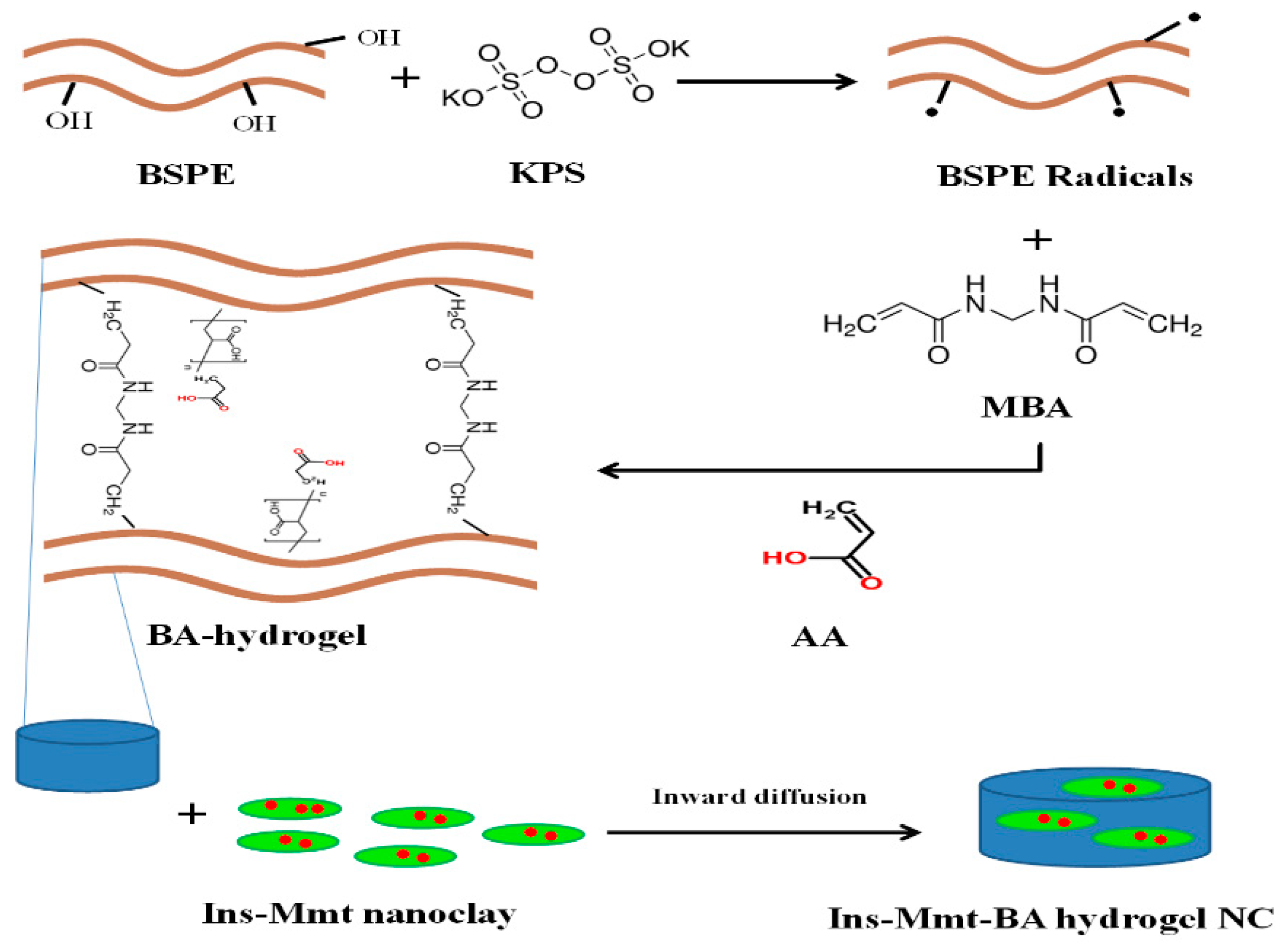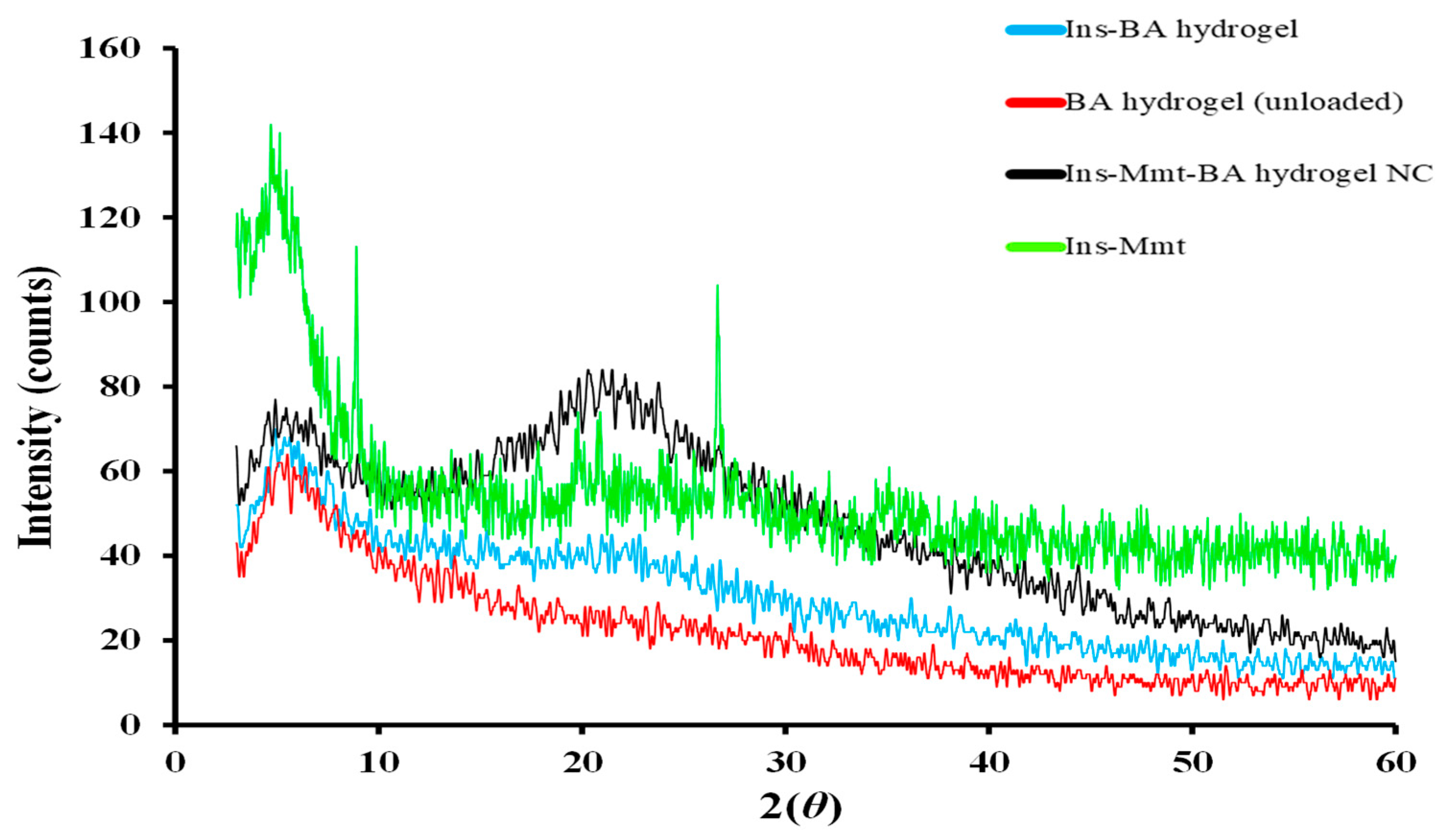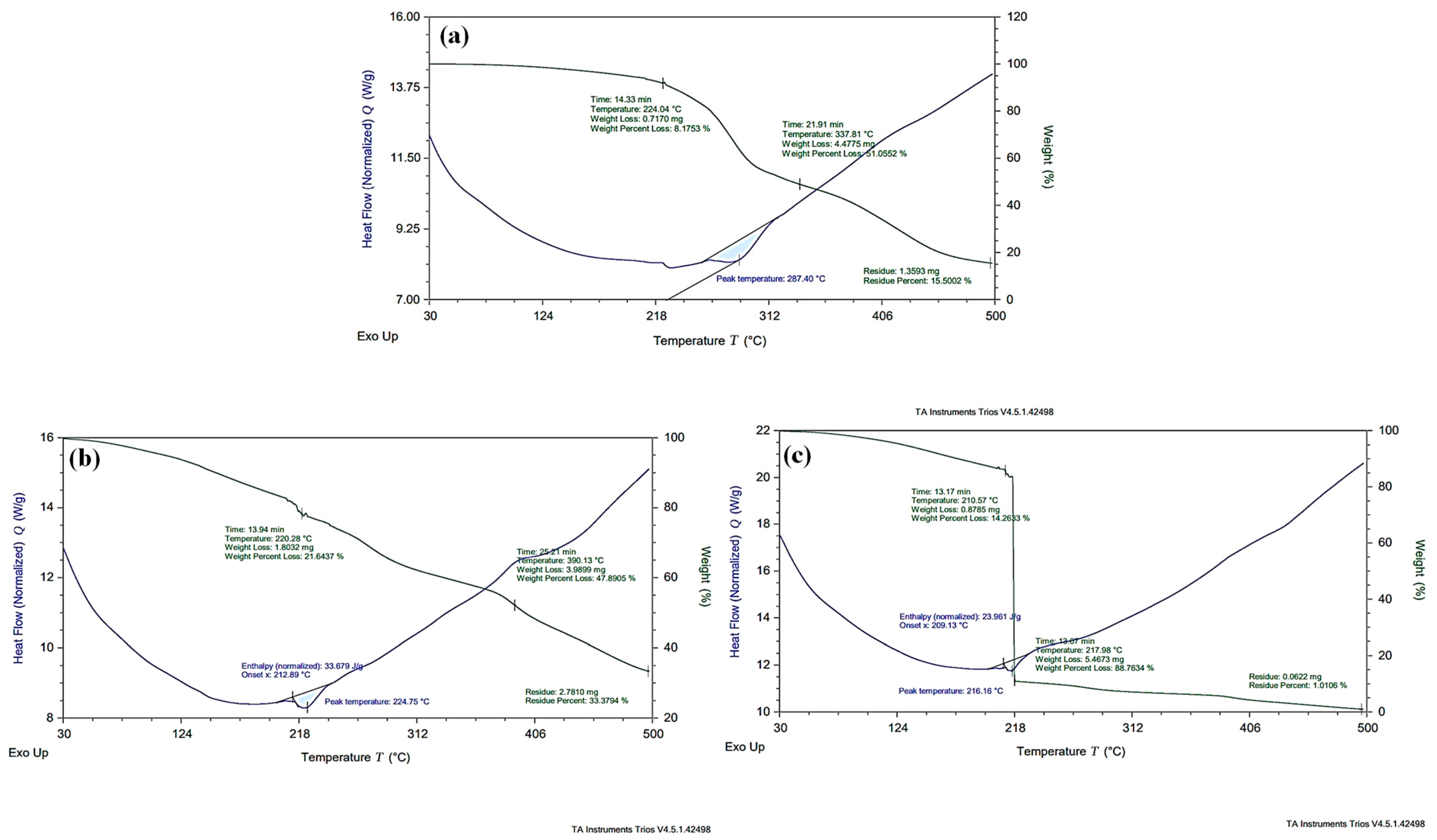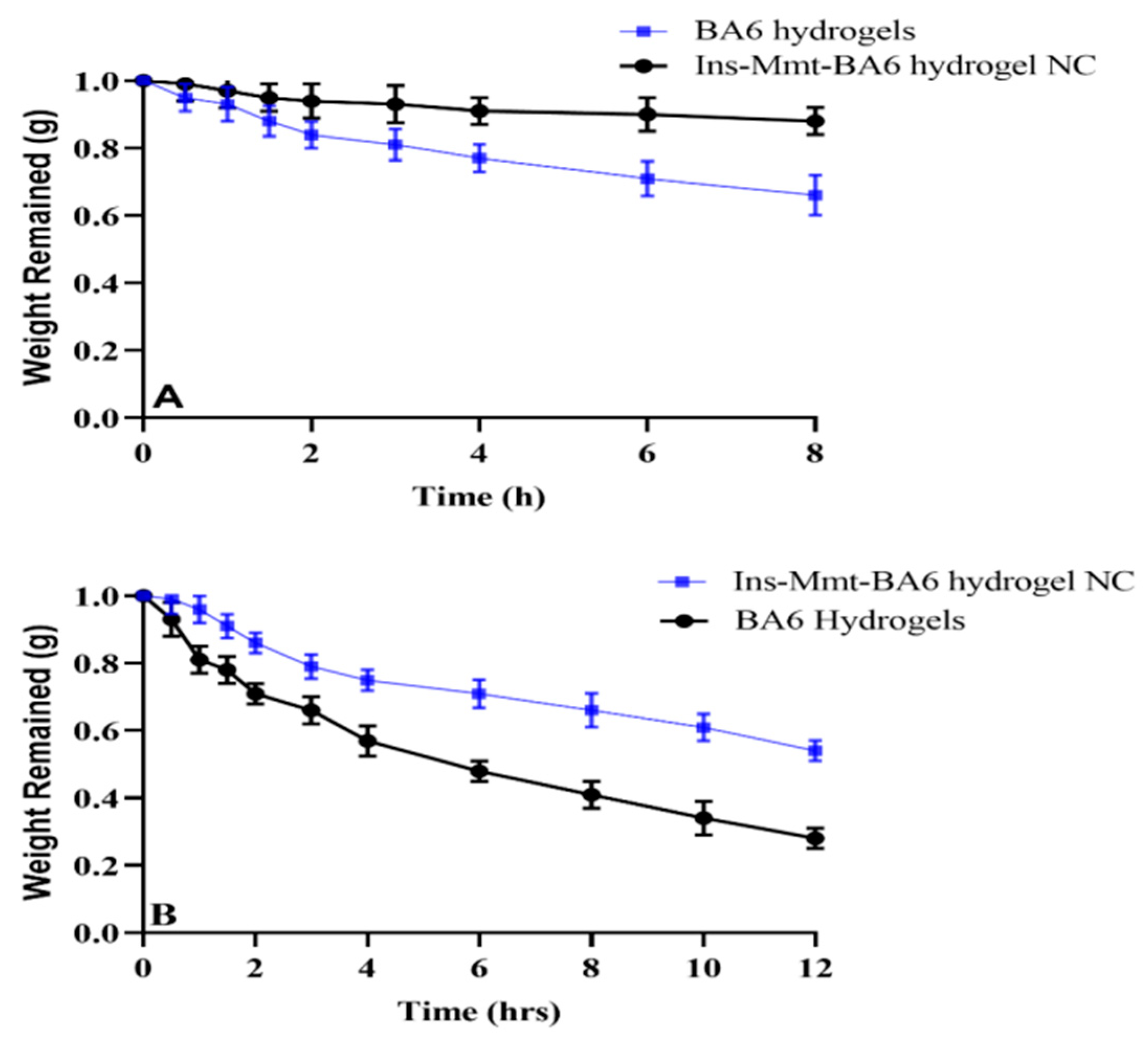Novel Black Seed Polysaccharide Extract-g-Poly (Acrylate) pH-Responsive Hydrogel Nanocomposites for Safe Oral Insulin Delivery: Development, In Vitro, In Vivo and Toxicological Evaluation
Abstract
1. Introduction
2. Experimental
2.1. Materials
2.2. Extraction of Black Seed Polysaccharide Extract (BSPE)
2.3. Process of Ins-Mmt-BA Hydrogel Nanocomposite Development
2.3.1. Development of BA Hydrogels
2.3.2. Preparation of Insulin Intercalated Mmt-Na+ (Ins-Mmt) Nanoclay
2.3.3. Loading of Ins-Mmt into BA Hydrogels to Develop Ins-Mmt-BA Hydrogel NCs
2.4. Directly Insulin-Loaded BA Hydrogel (Ins-BA) Development for Comparison
2.5. Performance of Swelling Studies
2.6. Measurement of Drug Loading Efficiency (% DLE)
2.7. Sol-Gel Fraction Determination
2.8. Fourier Transformed Infrared (FTIR) Spectroscopy
2.9. Scanning Electron Microscopy (SEM)
2.10. Energy Dispersive X-ray Spectroscopic (EDX) Analysis
2.11. Powdered X-ray Diffraction Analysis (PXRD)
2.12. Differential Scanning Calorimetry and Thermogravimetric Analysis (DSC and TGA)
2.13. In Vitro Insulin Release Measurements
2.14. Application of Kinetic Models of Drug Release
2.15. Acute Oral Toxicity Studies
2.16. In Vivo Pharmacodynamics Parameters Evaluation
2.17. HPLC Method Development and Pharmacokinetic Evaluation
2.18. In Vitro Biodegradation Studies
2.19. Statistical Data Analysis
3. Results and Discussion
3.1. Preparation of Black Seed Polysaccharide Extract (BSPE)
3.2. Preparation of Insulin-Loaded BA Hydrogels and Ins-Mmt-BA Hydrogel NCs
3.3. Swelling Studies
3.4. Drug Loading Determination and Their Inter-Relationship with Swelling
3.5. Sol-Gel Analysis of BA Hydrogels versus Ins-Mmt-BA Hydrogel NCs
3.6. FTIR Analysis
3.7. Scanning Electron Microscopy (SEM)
3.8. Energy Dispersive X-ray Spectroscopic Analysis (EDS)
3.9. Powdered X-ray Diffraction (PXRD) Analysis
3.10. Thermal Studies/Differential Scanning Calorimetry (DSC) and Thermogravimetric Analysis (TGA)
3.11. In Vitro Release Studies
3.12. Kinetic Modelling of Release Data
3.13. Acute Oral Toxicity Studies
3.14. In Vivo Pharmacodynamics Parameters Evaluation
3.15. Pharmacokinetic Evaluation
3.16. In Vitro Biodegradtion Studies
4. Conclusions
Supplementary Materials
Author Contributions
Funding
Institutional Review Board Statement
Informed Consent Statement
Data Availability Statement
Acknowledgments
Conflicts of Interest
References
- Teo, Z.L.; Tham, Y.C.; Yu, M.C.; Chee, M.L.; Rim, T.H.; Cheung, N.; Bikbov, M.M.; Wang, Y.X.; Tang, Y.; Lu, Y.; et al. Global Prevalence of Diabetic Retinopathy and Projection of Burden through 2045: Systematic Review and Meta-analysis. Ophthalmology 2021, 128, 1580–1591. [Google Scholar] [CrossRef]
- Kalousová, M.; Fialová, L.; Skrha, J.; Zima, T.; Soukupová, J.; Malbohan, I.M.; Stipek, S. Oxidative stress, inflammation and autoimmune reaction in type 1 and type 2 diabetes mellitus. Prague Med. Rep. 2004, 105, 21–28. [Google Scholar]
- Ozougwu, J.C.; Obimba, K.C.; Belonwu, C.D.; Unakalamba, C.B. The pathogenesis and pathophysiology of type 1 and type 2 diabetes mellitus. J. Physiol. Pathophysiol. 2013, 4, 46–57. [Google Scholar] [CrossRef]
- Gregory, J.M.; Moore, D.J.; Simmons, J.H. Type 1 diabetes mellitus. Pediatr. Rev. 2013, 34, 203–215. [Google Scholar] [CrossRef]
- Gedawy, A.; Martinez, J.; Al-Salami, H.; Dass, C.R. Oral insulin delivery: Existing barriers and current counter-strategies. J. Pharm. Pharmacol. 2018, 70, 197–213. [Google Scholar] [CrossRef]
- Humulin® R Regular Insulin Human Injection, USP, (rDNA Origin) 100 Units Per mL (U-100) [Leaflet]; Lilly USA LLC: Indianapolis, IN, USA, 2011.
- Xiao, Y.; Tang, Z.; Wang, J.; Liu, C.; Kong, N.; Farokhzad, O.C.; Tao, W. Oral insulin delivery platforms: Strategies to address the biological barriers. Angew. Chem. Int. Ed. 2020, 59, 19787–19795. [Google Scholar] [CrossRef]
- Li, S.; Chen, Z.; Wang, J.; Yan, L.; Chen, T.; Zeng, Q. Fabrication and characterization of a novel semi-interpenetrating network hydrogel based on sodium carboxymethyl cellulose and poly (methacrylic acid) for oral insulin delivery. J. Biomater. Appl. 2020, 35, 3–14. [Google Scholar] [CrossRef]
- Luo, Y.Y.; Xiong, X.Y.; Tian, Y.; Li, Z.L.; Gong, Y.C.; Li, Y.P. A review of biodegradable polymeric systems for oral insulin delivery. Drug Deliv. 2016, 23, 1882–1891. [Google Scholar] [CrossRef]
- Kamari, Y.; Ghiaci, P.; Ghiaci, M. Study on montmorillonite/insulin/TiO2 hybrid nanocomposite as a new oral drug-delivery system. Mater. Sci. Eng. C 2017, 75, 822–828. [Google Scholar] [CrossRef]
- Sarmento, B.; Martins, S.; Ferreira, D.; Souto, E.B. Oral insulin delivery by means of solid lipid nanoparticles. Int. J. Nanomed. 2007, 2, 743–749. [Google Scholar]
- Boushra, M.; Tous, S.; Fetih, G.; Xue, H.Y.; Tran, N.T.; Wong, H.L. Methocel-lipid hybrid nanocarrier for efficient oral insulin delivery. J. Pharm. Sci. 2016, 105, 1733–1740. [Google Scholar] [CrossRef] [PubMed]
- Aguirre, T.A.; Teijeiro-Osorio, D.; Rosa, M.; Coulter, I.S.; Alonso, M.J.; Brayden, D.J. Current status of selected oral peptide technologies in advanced preclinical development and in clinical trials. Adv. Drug Deliv. Rev. 2016, 106, 223–241. [Google Scholar] [CrossRef] [PubMed]
- Taylor, M.J.; Chauhan, K.P.; Sahota, T.S. Gels for constant and smart delivery of insulin. Br. J. Diabetes 2020, 20, 41–51. [Google Scholar] [CrossRef]
- Baig, N.; Kammakakam, I.; Falath, W. Nanomaterials: A review of synthesis methods, properties, recent progress, and challenges. Mater. Adv. 2021, 2, 1821–1871. [Google Scholar]
- Mtibe, A.; Mokhothu, T.H.; John, M.J.; Mokhena, T.C.; Mochane, M.J. Fabrication and characterization of various engineered nanomaterials. In Handbook of Nanomaterials for Industrial Applications; Elsevier: Amsterdam, The Netherlands, 2018; pp. 151–171. [Google Scholar]
- Song, F.; Li, X.; Wang, Q.; Liao, L.; Zhang, C. Nanocomposite hydrogels and their applications in drug delivery and tissue engineering. J. Biomed. Nanotechnol. 2015, 11, 40–52. [Google Scholar] [CrossRef]
- Lavrador, P.; Esteves, M.R.; Gaspar, V.M.; Mano, J.F. Stimuli-Responsive Nanocomposite Hydrogels for Biomedical Applications. Adv. Funct. Mater. 2021, 31, 2005941. [Google Scholar] [CrossRef]
- Trigui, I.; Yaich, H.; Sila, A.; Cheikh-Rouhou, S.; Bougatef, A.; Blecker, C.; Attia, H.; Ayadi, M.A. Physicochemical properties of water-soluble polysaccharides from black cumin seeds. Int. J. Biol. Macromol. 2018, 117, 937–946. [Google Scholar] [CrossRef]
- Joshi, G.V.; Kevadiya, B.D.; Patel, H.A.; Bajaj, H.C.; Jasra, R.V. Montmorillonite as a drug delivery system: Intercalation and in vitro release of timolol maleate. Int. J. Pharm. 2009, 374, 53–57. [Google Scholar] [CrossRef]
- Joshi, G.V.; Patel, H.A.; Kevadiya, B.D.; Bajaj, H.C. Montmorillonite intercalated with vitamin B1 as drug carrier. App. Clay Sci. 2009, 45, 248–253. [Google Scholar] [CrossRef]
- Whittingham, J.L.; Scott, D.J.; Chance, K.; Wilson, A.; Finch, J.; Brange, J.; Dodson, G.G. Insulin at pH 2: Structural analysis of the conditions promoting insulin fibre formation. J. Mol. Biol. 2002, 318, 479–490. [Google Scholar] [CrossRef]
- Karadag, E.; Hasgul, B.; Kundakci, S.; Uzum, O.B. Montmorillonite loaded highly swollen AAm/AMPS hydrogels and semi-IPNs with PEG as a novel composite polymeric sorbent for water and dye sorption. Polym. Technol. Eng. 2014, 53, 1259–1271. [Google Scholar] [CrossRef]
- Shabir, F.; Erum, A.; Tulain, U.R.; Hussain, M.A.; Ahmad, M.; Akhter, F. Preparation and characterization of pH sensitive crosslinked Linseed polysaccharides-co-acrylic acid/methacrylic acid hydrogels for controlled delivery of ketoprofen. Des. Monomers Polym. 2017, 20, 485–495. [Google Scholar] [CrossRef] [PubMed]
- Haseeb, M.T.; Hussain, M.A.; Yuk, S.H.; Bashir, S.; Nauman, M. Polysaccharides based superabsorbent hydrogel from Linseed: Dynamic swelling, stimuli responsive on–off switching and drug release. Carbohydr. Polym. 2016, 136, 750–756. [Google Scholar] [CrossRef]
- Malik, N.S.; Ahmad, M.; Alqahtani, M.S.; Mahmood, A.; Barkat, K.; Khan, M.T.; Tulain, U.R.; Rashid, A. β-cyclodextrin chitosan-based hydrogels with tunable pH-responsive properties for controlled release of acyclovir: Design, characterization, safety, and pharmacokinetic evaluation. Drug Deliv. 2021, 28, 1093–1108. [Google Scholar] [CrossRef]
- Guler, M.A.; Gok, M.K.; Figen, A.K.; Ozgumus, S. Swelling, mechanical and mucoadhesion properties of Mt/starch-g-PMAA nanocomposite hydrogels. Appl. Clay Sci. 2015, 112, 44–52. [Google Scholar] [CrossRef]
- Shah, N.; Patel, K. Formulation and development of hydrogel for poly acrylamide-co-acrylic acid. J. Pharm. Sci. Biosci. Res. 2014, 4, 114–120. [Google Scholar]
- Guven, M.N.; Altuncu, M.S.; Bal, T.; Oran, D.C.; Gulyuz, U.; Kizilel, S.; Okay, O.; Avci, D. Bisphosphonic acid-functionalized cross-linkers to tailor hydrogel properties for biomedical applications. ACS Omega 2018, 3, 8638–8647. [Google Scholar] [CrossRef]
- Ranjha, N.M.; Qureshi, U.F. Preparation and characterization of crosslinked acrylic acid/hydroxypropyl methyl cellulose hydrogels for drug delivery. Int. J. Pharm. Pharm. Sci. 2014, 6, 400–410. [Google Scholar]
- Feki, A.; Hamdi, M.; Jaballi, I.; Zghal, S.; Nasri, M.; Amara, I.B. Conception and characterization of a multi-sensitive composite chitosan-red marine alga-polysaccharide hydrogels for insulin controlled-release. Carbohydr. Polym. 2020, 236, 116046. [Google Scholar] [CrossRef]
- Al-Tabakha, M.M.; Khan, S.A.; Ashames, A.; Ullah, H.; Ullah, K.; Murtaza, G.; Hassan, N. Synthesis, characterization and safety evaluation of sericin-based hydrogels for controlled delivery of acyclovir. Pharmaceuticals 2021, 14, 234. [Google Scholar] [CrossRef]
- Khan, S.; Ahmad, M.; Murtaza, G.; Aamir, M.; Rehman, N.; Kousar, R.; Rasool, F.; Akhtar, M. Formulation of nimesulide floating microparticles using low-viscosity hydroxypropyl methylcellulose. Trop. J. Pharm. Res. 2010, 9, 293–299. [Google Scholar] [CrossRef][Green Version]
- Senol, S.; Akyol, E. Preparation and characterization of pH-sensitive hydrogels from photo-crosslinked poly (ethylene glycol) diacrylate incorporating titanium dioxide. Mater. Sci. Pol. 2020, 38, 443–449. [Google Scholar] [CrossRef]
- Hussain, H.R.; Bashir, S.; Mahmood, A.; Sarfraz, M.; Kanwal, M.; Ahmad, N.; Shah, H.S.; Nazir, I. Fenugreek seed mucilage grafted poly methacrylate pH-responsive hydrogel: A promising tool to enhance the oral bioavailability of methotrexate. Int. J. Biol. Macrmol. 2022, 202, 332–344. [Google Scholar] [CrossRef] [PubMed]
- Humadi, M.H.; Mubarak, Z.M.; Jamil, I.J. The Effects of Leptin Hormone Concentrations and Some Immunological and Biochemical Parameters in Alloxan Induced Diabetic Male Rabbits and Diabetic Treated with Alpha Lipoic Acid and L-Carnitine. Tikrit J. Pure Sci. 2018, 22, 1–7. [Google Scholar]
- Ravi, S.; Peh, K.K.; Darwis, Y.; Krishna Murthy, B.; Raghu Raj Singh, T. Development and validation of an HPLC–UV method for the determination of insulin in rat plasma: Application to pharmacokinetic study. Chromatographia 2007, 66, 805–809. [Google Scholar] [CrossRef]
- Rehman, U.; Sarfraz, R.M.; Mahmood, A.; Zafar, N.; Ashraf, M.U. Chitosan/Agarose-g-poly (methacrylate) pH responsive polymeric blend: A dais for controlled delivery of Capecitabine. Polym. Adv. Technol. 2021, 32, 3782–3794. [Google Scholar] [CrossRef]
- Batool, N.; Sarfraz, R.M.; Mahmood, A.; Zaman, M.; Zafar, N.; Salawi, A.; Almoshari, Y.; Alshamrani, M. Orally Administered, Biodegradable and Biocompatible Hydroxypropyl–β–Cyclodextrin Grafted Poly (methacrylic acid) Hydrogel for pH Sensitive Sustained Anticancer Drug Delivery. Gels 2022, 8, 190. [Google Scholar] [CrossRef]
- Mahmood, A.; Amara, S.F.M.; Sarfraz, R.M.; Abrar, M.A.; Qaisar, M.N.; Anwer, N.; Amjad, M.W.; Zaman, M. Development and in vitro evaluation of (β-cyclodextrin-g-methacrylic acid)/Na+-montmorillonite nanocomposite hydrogels for controlled delivery of lovastatin. Int. J. Nanomed. 2019, 14, 5397. [Google Scholar] [CrossRef]
- Rezazadeh, B.; Sirousazar, M.; Abbasi-Chianeh, V.; Kheiri, F. Polymer-clay nanocomposite hydrogels for molecular irrigation application. J. Appl. Polym. Sci. 2020, 137, 48631. [Google Scholar] [CrossRef]
- Lim, L.S.; Rosli, N.A.; Ahmad, I.; Mat Lazim, A.; Mohd Amin, M.C. Synthesis and swelling behavior of pH-sensitive semi-IPN superabsorbent hydrogels based on poly (acrylic acid) reinforced with cellulose nanocrystals. Nanomater 2017, 7, 399. [Google Scholar] [CrossRef]
- Bashir, S.; Teo, Y.Y.; Naeem, S.; Ramesh, S.; Ramesh, K. pH responsive N-succinyl chitosan/Poly (acrylamide-co-acrylic acid) hydrogels and in vitro release of 5-fluorouracil. PLoS ONE 2017, 12, e0179250. [Google Scholar]
- Romo-Cardenas, G.; Sanchez-Lopez, J.D.; Luque, P.A.; Cosio-Leon, M.; Nieto-Hipolito, J.I.; Vazquez-Briseno, M. Insulin overlapping in whole blood FTIR spectroscopy in blood glucose measurements. Results Phys. 2017, 7, 1221–1222. [Google Scholar] [CrossRef]
- Hoidy, W.H.; Ahmad, M.B.; Mulla, A.A.; Ibrahim, N.A. Synthesis and characterization of organoclay from sodium montmorillonite and fatty hydroxamic acids. Am. J. Appl. Sci. 2009, 6, 1567. [Google Scholar] [CrossRef]
- Gholamali, I.; Yadollahi, M. Doxorubicin-loaded carboxymethyl cellulose/Starch/ZnO nanocomposite hydrogel beads as an anticancer drug carrier agent. Int. J. Biol. Macromol. 2020, 160, 724–735. [Google Scholar] [CrossRef]
- Liu, D.; Yu, B.; Jiang, G.; Yu, W.; Zhang, Y.; Xu, B. Fabrication of composite microneedles integrated with insulin-loaded CaCO3 microparticles and PVP for transdermal delivery in diabetic rats. Mater. Sci. Eng. C 2018, 90, 180–188. [Google Scholar] [CrossRef]
- Bueche, B. The Effect of PEG-Insulin and Insulin Hexamer Assembly on Stability in Solution and Dry Powders. Hexamer Assembly of PEGylated-Insulin and Insulin Studied by Multi-Angle Light Scattering to Rationally Choose the pH and Zinc Content for Analytical Methods and Formulations of Dry Powders. Ph.D. Thesis, University of Bradford, Bradford, UK, 2013. [Google Scholar]
- Mady, M.M.; Elshemey, W.M. Interaction of dipalmitoylphosphatidylcholine (DPPC) liposomes and insulin. Mol. Phys. 2011, 109, 1593–1598. [Google Scholar] [CrossRef]
- Shyong, Y.J.; Tsai, C.C.; Lin, R.F.; Soung, H.S.; Hsieh, H.C.; Hsueh, Y.S.; Chang, K.C.; Lin, F.H. Insulin-loaded hydroxyapatite combined with macrophage activity to deliver insulin for diabetes mellitus. J. Mater. Chem. B 2015, 3, 2331–2340. [Google Scholar] [CrossRef] [PubMed]
- Kevadiya, B.D.; Joshi, G.V.; Patel, H.A.; Ingole, P.G.; Mody, H.M.; Bajaj, H.C. Montmorillonite-alginate nanocomposites as a drug delivery system: Intercalation and in vitro release of vitamin B1 and vitamin B6. J. Biomater. App. 2010, 25, 161–177. [Google Scholar] [CrossRef]
- Huanbutta, K.; Sangnim, T. Design and development of zero-order drug release gastroretentive floating tablets fabricated by 3D printing technology. J. Drug Deliv. Sci. Technol. 2019, 52, 831–837. [Google Scholar] [CrossRef]
- Brazel, C.S.; Peppas, N.A. Mechanisms of solute and drug transport in relaxing, swellable, hydrophilic glassy polymers. Polymer 1999, 40, 3383–3398. [Google Scholar] [CrossRef]
- Gao, X.; He, C.; Xiao, C.; Zhuang, X.; Chen, X. Biodegradable pH-responsive polyacrylic acid derivative hydrogels with tunable swelling behavior for oral delivery of insulin. Polymer 2013, 54, 1786–1793. [Google Scholar] [CrossRef]
- Mukhopadhyay, P.; Sarkar, K.; Bhattacharya, S.; Bhattacharyya, A.; Mishra, R.; Kundu, P.P. pH sensitive N-succinyl chitosan grafted polyacrylamide hydrogel for oral insulin delivery. Carbohydr. Polym. 2014, 112, 627–637. [Google Scholar] [CrossRef] [PubMed]
- Qi, X.; Yuan, Y.; Zhang, J.; Bulte, J.W.; Dong, W. Oral administration of salecan-based hydrogels for controlled insulin delivery. J. Agric. Food Chem. 2018, 66, 10479–10489. [Google Scholar] [CrossRef] [PubMed]













| Formulation Codes | MBA (g/100 g) | AA (g/100 g) |
|---|---|---|
| BA1 | 0.3 | 15 |
| BA2 | 0.4 | 15 |
| BA3 | 0.5 | 15 |
| BA4 | 0.2 | 10 |
| BA5 | 0.2 | 12.5 |
| BA6 | 0.2 | 17.5 |
| Formulation Codes | DLE% ± S.E.M | Maximum Swelling Ratio (q) ± S.E.M |
|---|---|---|
| BA1 | 86.67 ± 1.03 | 31.72 ± 0.85 |
| BA2 | 80.53 ± 3.21 | 28.21 ± 0.73 |
| BA3 | 70.45 ± 4.42 | 20.18 ± 0.69 |
| BA4 | 72.58 ± 2.57 | 29.38 ± 0.77 |
| BA5 | 78.91 ± 1.85 | 42.75 ± 0.81 |
| BA6 | 90.33 ± 3.15 | 55.55 ± 0.88 |
| Ins-Mmt-BA1 | 81.24 ± 2.57 | 30.12 ± 0.84 |
| Ins-Mmt-BA2 | 75.47 ± 1.54 | 27.38 ± 0.79 |
| Ins-Mmt-BA3 | 66.67 ± 2.33 | 18.92 ± 0.43 |
| Ins-Mmt-BA4 | 68.11 ± 3.09 | 27.02 ± 0.75 |
| Ins-Mmt-BA5 | 74.37 ± 2.76 | 40.54 ± 0.82 |
| Ins-Mmt-BA6 | 85.45 ± 3.51 | 52.34 ± 0.84 |
| BA | Mmt-Na+ | Ins-Mmt-BA | |||
|---|---|---|---|---|---|
| Elements | Composition (%) | Elements | Composition (%) | Elements | Composition (%) |
| C | 57.32 | O | 55.81 | C | 36.27 |
| N | 9.14 | Mg | 0.98 | N | 8.88 |
| O | 33.23 | Al | 6.18 | O | 28.94 |
| K | 0.31 | Na | 1.08 | Na | 7.99 |
| Si | 34.73 | Mg | 0.27 | ||
| K | 0.64 | Al | 1.43 | ||
| Ca | 0.20 | Si | 3.99 | ||
| Ti | 0.25 | P | 10.31 | ||
| Fe | 1.22 | S | 0.35 | ||
| K | 0.26 | ||||
| Ca | 1.31 | ||||
| Clinical Findings | Group 1 (Control) | Group 2 (Treated) |
|---|---|---|
| Illness Signs | Not Seen | Not Seen |
| Body weight (kg) | ||
| Pre-treatment | 1.76 ± 0.03 | 1.81 ± 0.02 |
| Day 1 | 1.83 ± 0.01 | 1.84 ± 0.03 |
| Day 7 | 1.81 ± 0.02 | 1.93 ± 0.01 |
| Day 14 | 1.91 ± 0.03 | 1.89 ± 0.03 |
| Food intake (g) | ||
| Pre-treatment | 72.33 ± 1.03 | 74.76 ± 0.99 |
| Day 1 | 71.56 ± 1.34 | 73.33 ± 1.23 |
| Day 7 | 75.32 ± 1.05 | 72.84 ± 0.98 |
| Day 14 | 77.29 ± 1.47 | 75.91 ± 1.17 |
| Water intake (mL) | ||
| Pre-treatment | 160.73 ± 1.76 | 172.88 ± 1.45 |
| Day 1 | 165.32 ± 1.54 | 169.71 ± 1.24 |
| Day 7 | 171.32 ± 1.05 | 175.32 ± 1.37 |
| Day 14 | 177.29 ± 1.47 | 172.92 ± 1.31 |
| Dermal irritation | Not observed | Not observed |
| Ocular irritation | Not seen | Not seen |
| Mortality | No | No |
| Blood Parameter (Unit) | Group 1 (Control) | Group 2 (Treated) |
|---|---|---|
| Haemoglobin (g/dL) | 11.7 ± 0.47 | 12.53 ± 0.52 |
| Total RBCs (×1012/L) | 4.76 ± 0.13 | 5.11 ± 0.16 |
| Haematocrit (%) | 43 ± 0.98 | 49 ± 0.76 |
| Mean Corpuscular Volume (fL) | 75 ± 1.21 | 69 ± 1.34 |
| Mean Corpuscular Haemoglobin (pg) | 25 ± 0.65 | 23 ± 0.61 |
| Mean Corpuscular Haemoglobin Conc. (g/dL) | 27 ± 0.45 | 31 ± 0.53 |
| Platelet Count (×109/L) | 313 ± 3.55 | 267 ± 3.08 |
| WBC (TLC) (×109/L) | 9.2 ± 0.43 | 7.7 ± 0.51 |
| Neutrophils (%) | 62 ± 2.12 | 70 ± 2.33 |
| Lymphocytes (%) | 35 ± 1.23 | 41 ± 1.52 |
| Eosinophil (%) | 02 ± 0.44 | 03 ± 0.57 |
| Monocytes (%) | 03 ± 0.32 | 04 ± 0.38 |
| Biochemical Parameter (Unit) | Group 1 (Control) | Group 2 (Treated) |
|---|---|---|
| Bilirubin Total (mg/dL) | 0.5 ± 0.01 | 0.7 ± 0.02 |
| SGPT/ALT (IU/L) | 35 ± 1.23 | 37 ± 1.54 |
| SGOT/AST (IU/L) | 31 ± 1.12 | 34 ± 1.09 |
| Alkaline Phosphatase (U/L) | 103 ± 2.46 | 111 ± 3.51 |
| Urea (mg/dL) | 34 ± 1.29 | 36 ± 1.48 |
| Creatinine (mg/dL) | 0.9 ± 0.05 | 0.8 ± 0.04 |
| Uric Acid (mg/dL) | 5.6 ± 0.27 | 4.9 ± 0.19 |
| Triglycerides (mg/dL) | 78 ± 2.18 | 72 ± 2.05 |
| Formulation * | pK Parameters | |||||||
|---|---|---|---|---|---|---|---|---|
| Cmax (µg/mL) | tmax (h) | t1/2 (h) | MRT (h) | (AUC)0–∞ (µg h/mL) | Cl (mL/h) | Vd (mL) | RBA (%) | |
| SC insulin standard | 1.735 | 3 | 3.493 | 6.007 | 12.985 | 13.361 | 67.326 | |
| Oral Ins-BA hydrogel | 0.288 | 8 | 1.065 | 9.608 | 2.616 | 132.630 | 203.83 | 10.07 |
| Oral Ins-Mmt-BA hydrogel NC | 0.347 | 20 | 7.978 | 24.390 | 6.831 | 50.799 | 584.66 | 26.3 |
Disclaimer/Publisher’s Note: The statements, opinions and data contained in all publications are solely those of the individual author(s) and contributor(s) and not of MDPI and/or the editor(s). MDPI and/or the editor(s) disclaim responsibility for any injury to people or property resulting from any ideas, methods, instructions or products referred to in the content. |
© 2022 by the authors. Licensee MDPI, Basel, Switzerland. This article is an open access article distributed under the terms and conditions of the Creative Commons Attribution (CC BY) license (https://creativecommons.org/licenses/by/4.0/).
Share and Cite
Shabir, F.; Mahmood, A.; Zafar, N.; Zaman, M.; Sarfraz, R.M.; Ijaz, H. Novel Black Seed Polysaccharide Extract-g-Poly (Acrylate) pH-Responsive Hydrogel Nanocomposites for Safe Oral Insulin Delivery: Development, In Vitro, In Vivo and Toxicological Evaluation. Pharmaceutics 2023, 15, 62. https://doi.org/10.3390/pharmaceutics15010062
Shabir F, Mahmood A, Zafar N, Zaman M, Sarfraz RM, Ijaz H. Novel Black Seed Polysaccharide Extract-g-Poly (Acrylate) pH-Responsive Hydrogel Nanocomposites for Safe Oral Insulin Delivery: Development, In Vitro, In Vivo and Toxicological Evaluation. Pharmaceutics. 2023; 15(1):62. https://doi.org/10.3390/pharmaceutics15010062
Chicago/Turabian StyleShabir, Farya, Asif Mahmood, Nadiah Zafar, Muhammad Zaman, Rai Muhammad Sarfraz, and Hira Ijaz. 2023. "Novel Black Seed Polysaccharide Extract-g-Poly (Acrylate) pH-Responsive Hydrogel Nanocomposites for Safe Oral Insulin Delivery: Development, In Vitro, In Vivo and Toxicological Evaluation" Pharmaceutics 15, no. 1: 62. https://doi.org/10.3390/pharmaceutics15010062
APA StyleShabir, F., Mahmood, A., Zafar, N., Zaman, M., Sarfraz, R. M., & Ijaz, H. (2023). Novel Black Seed Polysaccharide Extract-g-Poly (Acrylate) pH-Responsive Hydrogel Nanocomposites for Safe Oral Insulin Delivery: Development, In Vitro, In Vivo and Toxicological Evaluation. Pharmaceutics, 15(1), 62. https://doi.org/10.3390/pharmaceutics15010062






